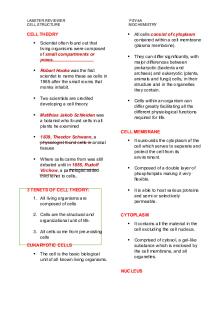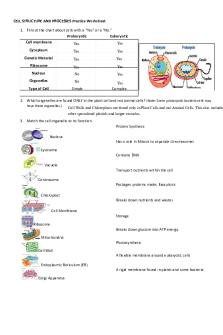Chap-1 Cell structure and functions PDF

| Title | Chap-1 Cell structure and functions |
|---|---|
| Author | Zeeshan Siddique |
| Course | Biology |
| Institution | University of Wah |
| Pages | 3 |
| File Size | 95.4 KB |
| File Type | |
| Total Downloads | 38 |
| Total Views | 138 |
Summary
Zeeshan Siddique, PhD Scholar (Biosciences)...
Description
BIOLOGY: 1ST YEAR
CHAPTER-1: CELL STRUCTURE & FUNCTION
Q.1: Define Biology: Biology is the branch of science deals with the study of living organisms. Q.2: Define botany: Botany is the branch of biology deals with the study of plants. Q.3: Define zoology: Zoology is the branch of biology deals with the study of animals. Q.4: What are main points of cell theory (What is cell)? i. ii. iii.
All living organisms are composed of one or more than one cell Cell is the basic structural & functional unit of living organism New cell arise from pre-existing cell by cell division
Q.5: What is difference between plant and animal cell? S.No 1 2 3
Plant Cell Plant cell have cell wall Plant cell have plastids. Cell wall is made of cellulose.
Animal Cell Animal cell do not have cell wall Animal cell do not have plastids. Plasma membrane is made of lipo-protein
Q.6: What is difference between prokaryotic and eukaryotic cell? S.No 1
2 3 4 5 6
Prokaryotic cell All the membrane bounded cell organelles are absent like mitochondria etc Do not have well definite nucleus Ribosome is of 70S Mitosis absent Cell wall made of murein Examples: bacteria, cyanobacteria
Eukaryotic cell All the membrane bounded cell organelles are present like mitochondria etc Have well definite nucleus Ribosome is of 80S Mitosis present Cell wall made of cellulose etc Examples: plants & animals
Q.7: Write note on cell wall: Cell wall is the outermost boundary in plant cell. It was discovered by Robert Hook in 1665. Its thickness varies from cell to cell. It is composed of cellulose.
i. ii. iii. i. ii. iii.
a) Parts of cell wall: Cell wall has three parts, they are: Primary wall: it is first wall formed in new cells. Secondary wall: it develops under the primary wall. Middle lamella: it is formed between two cells. b) Functions of cell wall: Cell wall has following function: It gives shape to the cells. It protects the inner parts of the cells. Movement of molecules takes place through cell wall.
Q.8: Write note on plasma membrane/cell membrane:
Plasma membrane or cell membrane is the outer most boundary of animal cells and inner to cell wall in plant cells. Cell membrane is chemically composed of lipids (20 – 40%) and protein (60 – 80%). a) Fluid mosaic model of cell membrane: According to fluid mosaic model “cell membrane is like a sea of lipids in which protein are floating”. b) Functions of cell membrane: i. It gives shape to the cells. ii. It protects the inner parts of the cells. iii. Movement of molecules takes place through cell wall. iv. Secrete useful substances. Q.9: Write note on endoplasmic reticulum: Endoplasmic reticulum is membrane bounded cell organelle in eukaryotic cells. Endoplasmic reticulum is the network of interconnected channels and tubes throughout the cytoplasm. There are two forms of endoplasmic reticulum: i. ii.
Rough endoplasmic reticulum: to which ribosomes are attached. Smooth endoplasmic reticulum: which are without the ribosomes.
Functions of endoplasmic reticulum: i. ii. iii. iv.
Endoplasmic reticulum helps in protein synthesis. It detoxifies the harmful drugs. It play role in transport of material within the cell. It gives mechanical support to the cell.
Q.10: Write note on mitochondria. Mitochondria are membrane bounded cell organelles in eukaryotic cells. They are granules like particles in cytoplasm. A mitochondrion is bounded by two membranes i.e i. ii.
Outer smooth membrane Inner folded membrane. These folds are called cristae.
Mitochondria have DNA and are self-replicating organelles. They are also called as “power house of cell” because aerobic respiration takes place in mitochondria. Q.11: What do you know about peroxisomes? Peroxisomes are also called microbodies. Peroxisomes are small sub-cellular bodies. They are surrounded by membranes. They are found in plant and animal cells. They have enzyme system. Q.12: Write note on Golgi apparatus (dictyosomes): Golgi apparatus was discovered by Camillo Golgi in 1898. It is found in eukaryotic cells. It is a complex system of interconnected tubules around the central stack. Golgi bodies helps in the storage of secretory products.
Q.13: What are lysosomes?
Lysosomes are found in eukaryotic cells. They are surrounded by single membrane. They contain digestive enzymes. Any foreign particle entering in cell is engulfed and digested by lysosomes. This is called phagocytosis. Sometime they eat the cell in which they are present. This is called autophagy. So they are also called as “suicide bags”. Q.14: Write note on nucleus: Nucleus was discovered by Robert Brown in 1838. It is spherical in shape. It is present in the center of animal cell. It controls all the activities of cell, so it is called brain of cell. It contains genetic information in the form of DNA. a) Parts of nucleus: Nucleus has four parts, they are: Nuclear membrane Nucleoplasm Nucleolus Chromosomes b) Functions of nucleus: i. It controls all the activities of cell. ii. It contains genetic information to pass on in next generation iii. It helps in protein synthesis
i. ii. iii. iv.
Q.15: What is tissue culture? Tissue culture is the growth of tissues and cells, separate from the organisms. Main steps: i. ii. iii. iv.
Selection of tissue from plant Sterilization of tissue Establishment of tissue in culture medium Growth of tissue in culture medium.
************...
Similar Free PDFs

Cell Structure and Magnification PPQ
- 28 Pages

Cell Structure SE 1
- 3 Pages

Labster 1 cell structure
- 10 Pages

Cell Structure (reviewer)
- 7 Pages

Structure of generalized cell
- 2 Pages

Cell Structure Worksheet
- 1 Pages

Cell Structure notes
- 13 Pages

Cell Structure Practice
- 3 Pages
Popular Institutions
- Tinajero National High School - Annex
- Politeknik Caltex Riau
- Yokohama City University
- SGT University
- University of Al-Qadisiyah
- Divine Word College of Vigan
- Techniek College Rotterdam
- Universidade de Santiago
- Universiti Teknologi MARA Cawangan Johor Kampus Pasir Gudang
- Poltekkes Kemenkes Yogyakarta
- Baguio City National High School
- Colegio san marcos
- preparatoria uno
- Centro de Bachillerato Tecnológico Industrial y de Servicios No. 107
- Dalian Maritime University
- Quang Trung Secondary School
- Colegio Tecnológico en Informática
- Corporación Regional de Educación Superior
- Grupo CEDVA
- Dar Al Uloom University
- Centro de Estudios Preuniversitarios de la Universidad Nacional de Ingeniería
- 上智大学
- Aakash International School, Nuna Majara
- San Felipe Neri Catholic School
- Kang Chiao International School - New Taipei City
- Misamis Occidental National High School
- Institución Educativa Escuela Normal Juan Ladrilleros
- Kolehiyo ng Pantukan
- Batanes State College
- Instituto Continental
- Sekolah Menengah Kejuruan Kesehatan Kaltara (Tarakan)
- Colegio de La Inmaculada Concepcion - Cebu







